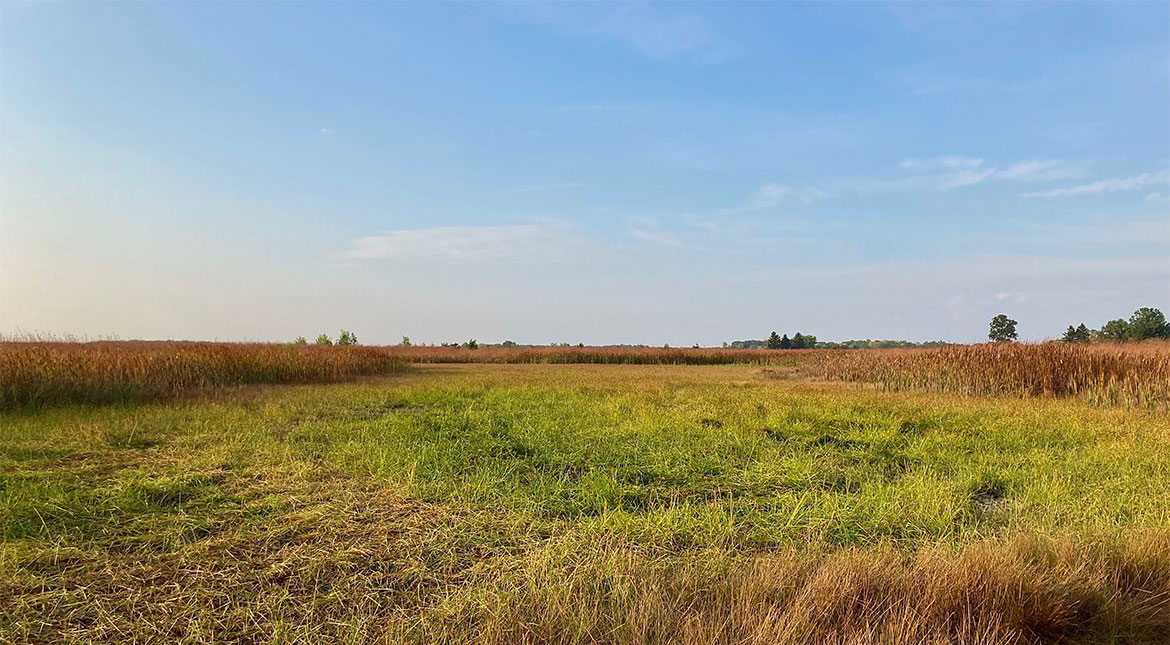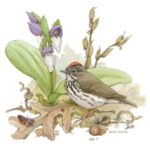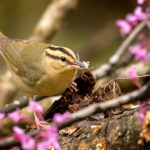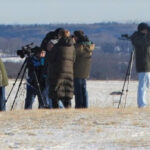Each month, our OOS Regional Directors are sharing their favorite birding hotspots in their respective regions – and beyond. These include some well-know destinations, specialty spots for specific species, and their own secret, treasured local patches. Have a favorite birding location? Reach out to your OOS Regional Director and let them know!
Amy Downing – Northwest Regional Director

Litzenberg Memorial Woods – Hancock County
This time of year I make many quick stops daily in my county, but I definitely have a few fall favorites in Hancock County where I can spend hiking most of the day. One of them for arriving Sparrows and migrating Warblers is Litzenberg Memorial Woods – South. The entire park is 227 acres including North and South side of the road with various habitats of deep ravines, old growth woods, creek and river bank, wetlands, expansive grasslands, and monitored bluebird area. The more familiar section is on the north side of US Route 224 with the historic McKinniss Homestead with gorgeous barns and period garden as well as a scenic, accessible walkway into the woods. Long-eared, Great Horned, Barred and Screech owls have been seen there. On the South property, the grassland is much larger, more wild and seemingly uncontrolled the nearer you get to the Blanchard River. Understandably the often-flooded river area makes it difficult to “develop and manage” into a modernized park, which is great for wildlife and birding. I love the wildness and ever-changing landscape that our river carves out! I was there on October 1, and as I walked the wooded horse trails with many lingering wild flowers along the trail and fall colors popping I stumbled into a busy pocket of birds including Black-throated Blue, Yellow-rumped and Palm Warblers chasing around. There were also heated exchanges with Black-capped Chickadees (we’re in the overlap zone with Carolina Chickadees too) and White and Red-breasted Nuthatches. There have been several times in the deep woods that I’ve found Barred Owls and nesting Wild Turkeys, once watched a Great-horned Owl take a Northern Flicker in mid flight, and in one of the wetland ponds I watched Sandhill Cranes taking off. The large grassland on the South side of the road has been a hot spot for most of the Ohio sparrows including Nelson’s, Lincoln’s, and Grasshopper Sparrows. With 185 species found since the first Ebird report in 1973, it’s got much to offer birders in all seasons but is most spectacular in its fall glory.
Kandace Glanville – Central Regional Director
Battelle Darby Creek Metro Park – Franklin County
I could go to this hotspot any month of the year and be rewarded with plenty of birds, but Battelle Darby Creek Metro Park in Franklin county is especially good in October. The Wet Prairie Teal and Harrier Trails are one of the best places in central Ohio to find a rare “orange sparrow” – that is, a Nelson’s or LeConte’s Sparrow which are sneaky and rare through Ohio in migration in the spring and in the fall in late September and early October. You’re also likely to find large flocks of thousands of staging blackbirds, including Rusty Blackbirds. These can often be difficult to track down in Ohio, but are rather frequent at Battelle during certain parts of the year. Even in October, the Battelle wetlands could be a decent shot for some late-migrant shorebirds, or early-migrant waterfowl and Short-eared Owls!

Diana Steele – Northeast Regional Director

Lorain Impoundment – Lorain County
Into the fall and winter the shoreline of Lake Erie becomes a very attractive place to bird. Influxes of usual and unusual migrants occur in waves as the winds carry them over the water to shelter on the shore. One of the most popular places to bird the lakefront in Lorain County is known as the “Lorain Impoundment.” Built up from sludge dumped from river dredging, it’s an unlikely looking and unattractive place, but on a good day, dozens of bird species of many types can be found there. Birders have recorded 269 species altogether. It’s a rarity magnet. Most recently a Brewer’s sparrow turned up; a first state record.
Only the satellite view on Google maps shows any land where the impoundment sits. To find it, use “Lakeside Landing” or “Mile Long Pier” in Lorain as the location. Access the dike by walking up a footpath from the parking lot and from there you can walk about a mile around the sheltered water of the impoundment. Look for ducks and waterfowl both in the impoundment and out on Lake Erie. Sparrows and blackbirds hug the scrubby grasses. Warblers, hawks, falcons—and even owls—collect in the few trees.
The Port Authority is currently implementing a plan to remove invasive phragmites and plant native species.
Jon Cefus – East Central Regional Director
Mahoning River/Berlin Lake – Stark County
This month, I will be birding the mudflats of the Mahoning River/Berlin Lake area of Stark County. This area is located along State Route 225 in eastern Stark County, north of Alliance. During October, we generally access the area by way of a small parking lot on Price St. 1/4 mile west of SR 225 on the north side of the road, just across the bridge over the river. Depending on the water levels, which vary according to the amount of rainfall and the amount of water allowed to flow towards the Ohio River by way of the U.S. Army Corps of Engineers, the areas we search could be either north or south of that parking area. You can scope areas north of the parking lot from the lot itself. As the conditions dry up, the activity works further north, then east, so conditions can change here every few days. Earlier in the season, or if large rainfall happens as was the case a few weeks ago, the better mudflats are located to the south. From the parking area, we walk across Price and enter the woods. You will see the mudflats/river area on your left. You can make your way along there south, and then to the west facing towards Deer Creek Reservoir’s spillway dam. Sometimes the best habitat is to the west in that direction, even wrapping around back to the north in a cove.
When conditions are better to the north, folks access the mudflats from a couple of rugged pulloffs north of Price on the west side of SR 225 just past Lowe Rd. Walking down to the mudflats to the west from there gives access to areas further north that are hard to scope from the parking lot on Price. You can walk all the way north to scan those areas and eventually you will see where the river turns east and you will see the causeway of SR 225 over the river. Some walk all the way to that causeway, then climb the concrete structure to access the road to walk back south to the pull offs, but that can be a long walk, and the walk up the causeway is rather steep, then you are walking back south along a busy road to your car, so be warned that this is not an easy way to go. Many walk to the north, scope for birds, then walk the mudflats back south to their car at the pull offs.
A scope is an absolute must here as are boots for muddy conditions. Be extremely careful walking on mudflats. Many an intrepid birder has lost their boot or become stuck in the mud needing help to get out. Staying closer to the woods offers less muddy conditions, and the added benefit of spotting migrant warblers and other birds along your way. Bird smarter, not harder.

Tyler Ficker – Southwest Regional Director

Fernald Nature Preserve – Hamilton / Butler County
Fernald Nature Preserve in Hamilton County is among my top hotspots for the entire state of Ohio! While there isn’t a bad time of year to visit here, October is the perfect mix of migrating songbirds and waterfowl! You can’t go wrong this time of year at Fernald!
Melissa Wales – Southeast Regional Director
Lake Snowden – Athens County
Lake Snowden is the number one birding hotspot in Athens County. Owned by Hocking College, this 675 acre recreation park offers excellent birding throughout the year. There are two ways to access the park. Coming from Athens City, take SR 50 southwest about 6 miles and turn right at Enlow Road, take an immediate left and then another left past a small farm to where the road dead ends at the dam side of the lake. There’s a small gravel parking lot on the right. The fish hatchery ponds on the left are routinely flooded and drained and offer opportunities for show birds and waterfowl. The horse trail off to the right meanders up the hill and down to the lake and is good for warblers, sparrows, and flycatchers. A walk up to the dam might reward you with mergansers and teals along the shoreline or perhaps Common Loons in the middle of the lake.
The main entrance is about a mile further down SR 50. Once inside the park, turn left into the campground and park at the horse trail entrance where you’ll enter a more mature forest patch where Red-headed Woodpeckers are found. Further in, that trail opens up to a farm field on the left and a scrubbier area on the right where Bobolinks have been seen in the fall.
Other good birding spots include the boathouse/beach area which is great for winter waterfowl. While birding Lake Snowden, be sure to keep you eyes to the skies for Bald Eagles, Norther Harriers and perhaps a Peregrine Falcon.





